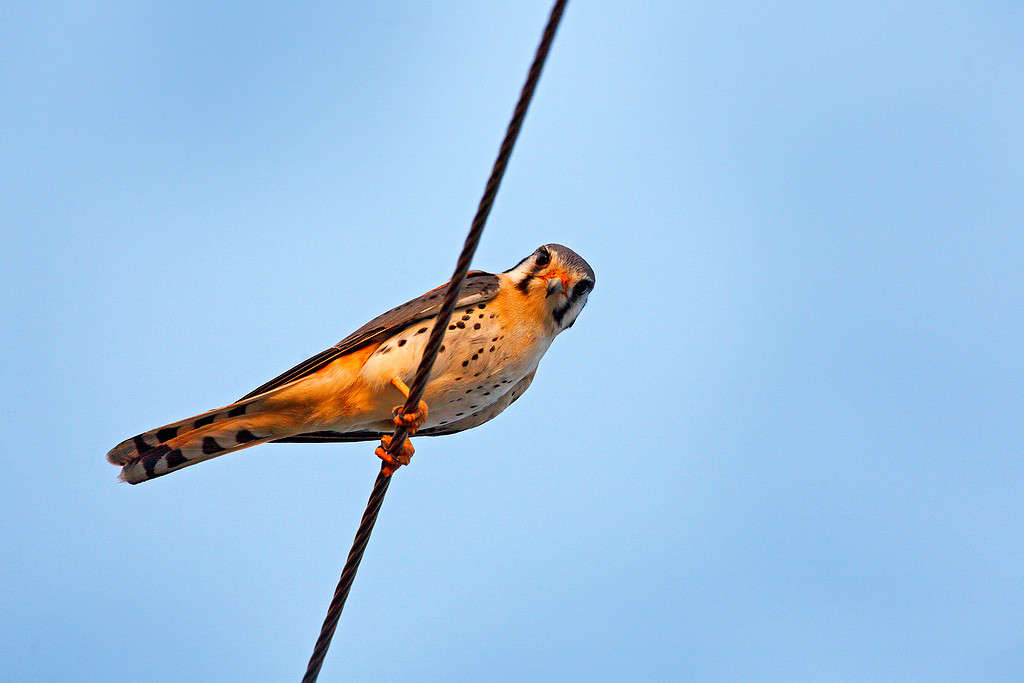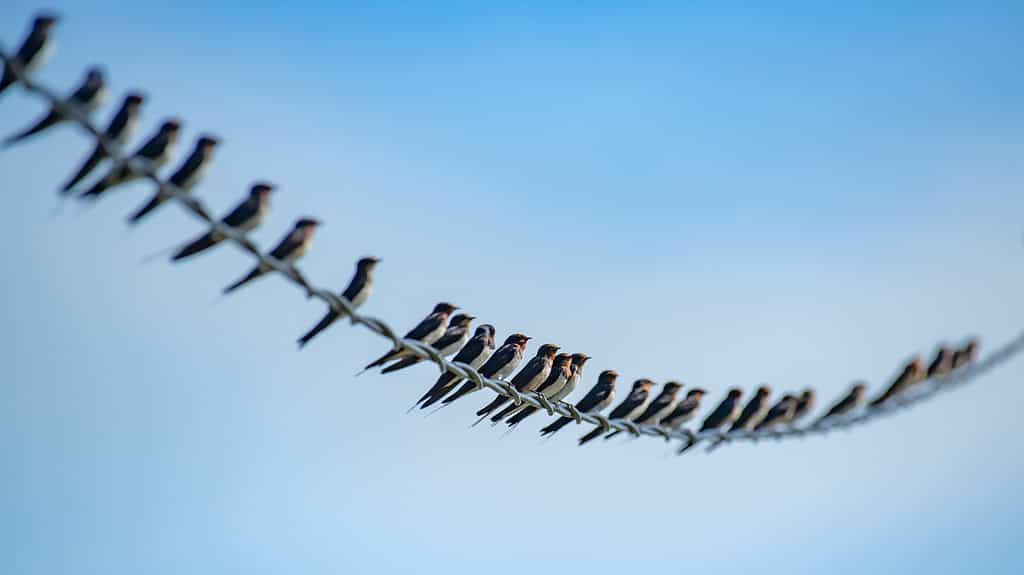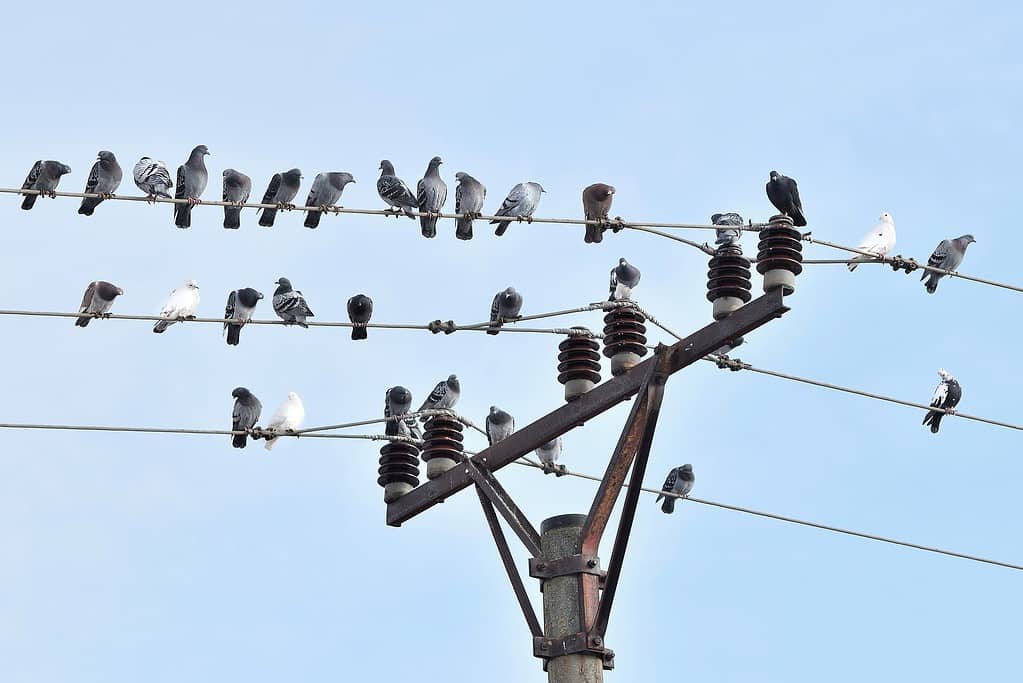Those feathery creatures seem to get away with something we’d never dare: sitting on power lines. If we see a phone line down, we freak out, assuming we could get shocked. So why do birds perch on power lines and how do they do it without dying?
Why Do Birds Perch on Power Lines?

Small birds congregate on power lines.
©Markus Gebauer/Shutterstock.com
Birds want the best view possible of their surroundings. This helps their safety and general awareness overall. It also helps them find food more easily by giving them a high perch clear enough to see all around them. There’s also warmth to be had, protection from predators, and, believe it or not, a social gathering place before migration.
How Do Power Lines Help Birds Find Food?
While birds perch high up on the power lines, they gain a clear view of their surroundings. Their excellent vision does the rest, homing in on insects, berries, fruit, nuts, and other food they couldn’t see from a lower perspective.
How Do Power Lines Protect Birds From Predators?
While birds hang out up there on the power lines, they also have safety from land predators like foxes, cats, and dogs. While some of these animals can climb up after them, the birds have a greater chance of flying away from power lines than from a bush or tree.
How Do Power Lines Keep Birds Warm?

American kestrels sometimes may be seen on wires. These birds perch on power lines to keep an eye out for prey, keep warm, and steer clear of larger birds of prey.
©Ondrej Prosicky/Shutterstock.com
Huddling together for warmth isn’t just done by humans on camping trips. As temperatures drop, power lines offer birds a safe place to collect together. Have you noticed how in winter they sit closer but in summer they spread out? It’s because of the warmth these huddling lines provide.
Birds can also easily perch on power lines and conserve energy while they rest and keep a watchful eye without as much stress. This allows them to relax more and absorb that warmth because of being less guarded.
Plus, it is electricity surging through the lines. This means the power lines warm birds from their feet, as well.
Do Birds Really Meet and Greet Before Flying South for the Winter?

Swallows often may be seen gathered together. Often, these birds perch on power lines before they make their migratory flight.
©Naturalism14/Shutterstock.com
Power lines are often seen covered in migratory birds in massive groupings before they embark on their migration treks. Pay attention next autumn or spring and see what happens. You’ll likely see big groups of a given bird species collecting together on the power lines for a couple of days. Then, poof! They’ll be gone for the season.
Why Don’t Birds Get Electrocuted on Power Lines?
All of that said, the next big question is how do they do it? How do birds perch on power lines without getting fried like us humans would?
The reality is birds can get shocked by power lines but only if they touch two power lines at the same time. Generally, this only occurs with larger bird species that have a harder time fitting on a single line with proper balance and feathers tucked away from the second power line. Two birds sitting on two different lines can also shock each other if they make contact with each other.
But in most cases, there’s no shock for the birds. And here’s why.
Birds Don’t Complete the Circuit
A single bird sitting on a single power line, not touching another bird or line does not complete the electrical circuit. This means the bird can sit, with its wings and tails tucked so they don’t make a connection with the power line and won’t get shocked.
The current doesn’t flow unless a circuit is completed. That is, unless there’s a difference in voltage between two points, the electrical current doesn’t flow. In most cases, a power line has only one wire running through it, carrying current. The high voltage remains the same between the bird and the wire unless something unusual occurs or the bird somehow closes the circuit with other connection points.
Birds Aren’t Great Electrical Conductors

Birds perch on power lines for many reasons. But notice how you almost never see any touch each other from other lines or touch two lines at once. These are part of how they stay alive while perched on such dangerous things.
©Coryn/Shutterstock.com
Birds aren’t high conductors. That is, they aren’t made of metal or other materials that naturally conduct electricity. This also significantly impacts their ability to chill on power lines without getting shocked. The dry feathers and scales on their legs effectively work as insulation for them, preventing conductivity in most situations.
For shock to occur, the bird would have to dramatically reduce its natural internal body resistance between the wire and the ground below what the system can handle.
Light Weight of Birds
Birds don’t weigh much, either, so they don’t generally weigh down the wires and cause lines to touch. This may vary from species to species, with some weighing as little as just a couple of ounces to large species weighing several pounds. But if you look up while a mourning dove sits on the wire, you won’t notice any dip in the power line — it looks straight and even.
Which Birds Sit on Power Lines?
In most cases, you’ll see small birds sitting on power lines. But not even all small bird species rest on them. You’ll most often witness the following species perched up there.
- Doves
- Pigeons
- Small raptors
- Swallows
- Martins
- Starlings
- Bluebirds
- Western kingbirds
- Loggerhead shrikes
- Blackbirds
- Grackles
Which Birds Do Not Sit on Power Lines?
Larger birds instinctively know not to sit on these lines. So you’re very unlikely to see crows, geese, herons, vultures, hawks, eagles, or ospreys sitting on them.
The photo featured at the top of this post is © Coryn/Shutterstock.com
Thank you for reading! Have some feedback for us? Contact the AZ Animals editorial team.







